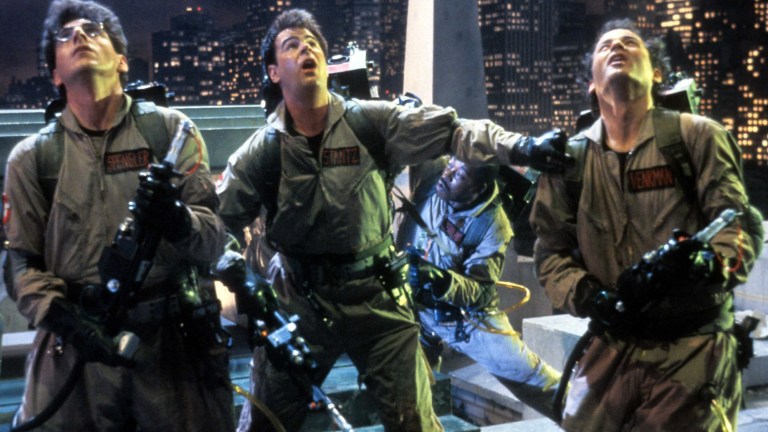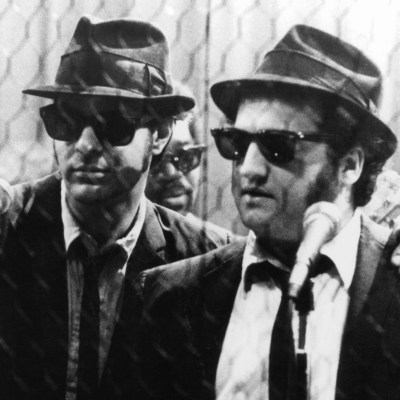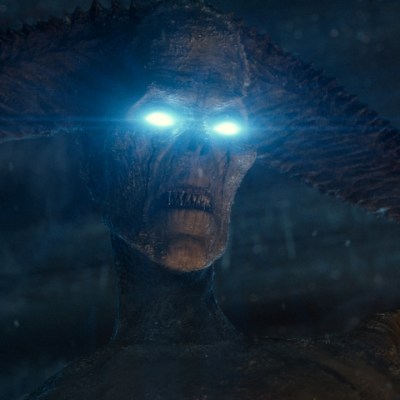Inside Dan Aykroyd’s ‘90s Ghostbusters 3 That Never Got Made
We examine Dan Aykroyd’s detailed notes and treatment from 1997 for a version of Ghostbusters 3 that was intended to star Chris Farley…

Forty years ago this summer, a perfect storm of moviemaking elements came together with almost supernatural precision: SNL alums like Dan Aykroyd and Bill Murray at the height of their popularity; director Ivan Reitman and co-writer Harold Ramis at the peak of their creativity; unexpectedly innovative and convincing VFX developed by Richard Edlund on a budget because ILM was too busy; and a weathered and weary New York City that, still a decade out from “urban renewal,” proved a perfect backdrop for a comedy about working stiffs going into business.
All these elements and more seemed to capture lightning in a bottle at a specific time and place for one of the great American comedies. In retrospect, it seems almost impossible to duplicate. But that doesn’t mean there was a lack of trying. Despite Ghostbusters being a singularly deadpanned ‘80s comedy, the film has generated cartoon spinoffs, video games, and of course big screen sequels. In the last decade alone, Sony has attempted to reboot the brand several times, first with a remake and then with several fawning legacy sequels which treat the idea of four guys driving around Tribeca in a hearse with the reverence of scripture.
Each of these new iterations have their fans, and yet there remains a gnawing question: what might have happened if Reitman, Ramis, Aykroyd, and all the rest came back for at least one more entry back in their prime? What would it have been like if Ayrkoyd got his coveted Ghostbusters III off the ground in the 1990s? This was after all a period stuffed with bonafide high-concept blockbuster sequels, and the old Ghostbusters guard were still putting out projects like Multiplicity, The Man Who Knew Too Little, and Six Days and Seven Nights.
Well, one detailed, 19-page story treatment by Aykroyd gives us a pretty good idea of what that Ghostbusters III might have been like… and why it would’ve been literal hell for the Ghostbusters.
What Fresh Ghostbusters Hell Was This?
Ironically, it was one of the bigger studio comedies of the ‘90s that finally saw Ghostbusters III gain traction at Sony’s Columbia Pictures. While Aykroyd had expressed interest in possibly doing another adventure with Ray Stantz, Peter Venkman, Egon Spengler, and Winston Zeddemore as early as the 1989 press tour for Ghostbusters II, no one else was particularly interested at the time.
Yet after enjoying a small but pivotal role in a Chris Farley starring vehicle, Tommy Boy (1995), Aykroyd became convinced that a third Ghostbusters movie could work, especially if they added Farley to the repertoire. Over the next several years, Aykroyd began developing a third Ghostbusters flick that eventually gained the working subtitle of “Hellbent.” By that point, Aykroyd had brought aboard as co-writer Tom Davis, one of the most popular SNL writers from that sketch comedy series’ 1970s glory days, to help refine the project as it encountered setback after setback going into the mid-2000s.
The most prominent of these setbacks was, of course, Bill Murray’s infamous reluctance to return to the brown jumpsuit and proton pack. Murray even allegedly sent one of Aykroyd and Davis’ later drafts of the Hellbent script back with a note that said, “No one wants to pay money to see fat, old men chasing ghosts.” While Aykroyd denied that note was ever written, even Murray has admitted to an estranged relationship with Ramis after a contentious production on 1993’s Groundhog Day.
Murray’s refusal to return, as well as that of Sigourney Weaver, and even some hesitancy from Reitman, repeatedly delayed the project until it was eventually mothballed in 2007.
Yet for the purposes of this article, we are less interested in the behind-the-scenes problems which contributed to the demise of Ghostbusters III/Hellbent/whatever else it might have been called than we are in understanding what the movie might have been like if it was produced when Aykroyd first got the inkling to do the film at a moment where the franchise wasn’t ancient, they were not quite Murray’s alleged “fat old men,” and Aykroyd’s first choice to be the next generation of ‘bustin’ was still alive. In other words, we’d like to look back at Aykroyd’s earliest February 1997 treatment when the only potential limitations were with what the material itself could have been.
Dan Aykroyd’s Original Vision for Ghostbusters 3
Dated Feb. 6, 1997, Ayrkoyd’s story treatment for a third Ghostbusters movie is defined by a series of very clever set pieces or visual moments that are interstitially connected by a plot that’s obviously still in early development. The general gist of this Dante-like story is that the Ghostbusters must navigate the various levels of Hell, but instead of it being an inferno circling ever downward, Aykroyd’s vision of everlasting perdition is…. basically Manhattan (or Manhellton) on a bad day.
How the Ghostbusters end up there begins promising enough. In a beat that would have played well during any montage of the undead in the first two Ghostbusters films, the third movie was intended to open after hours at a Yonkers funeral home where a relaxing attendant hears a knock at the door, only to see a woman we saw moments earlier in a state of repose in a coffin. Now she appears in the employee’s doorway in silhouette. The only thing lighting her is the fire from the cigarette she bums off his desk. “Ahhh, that’s good,” she purrs. “Now, I want to go home.”
The subsequent sequences are the most detailed and intriguing ideas in Aykroyd’s treatment: the confines of Hell have apparently filled up so much with the souls of the damned that the dead are rising from their graves. There’s no more room in Hell. Hence a sequence of one mourner throwing the first handful of dirt on the coffin of their beloved in a graveyard… only for the dirt to be thrown right back in their face. Afterward the entire cemetery is described as follows: “Coffins are popping up like corks in a pool and shooting out of the ground like missiles. Caskets are landing around them, splitting apart with the corpses walking out and heading for the road.”
It is in this chaos we get the script’s first fake out as Ecto-1 peels out of the beloved firehouse… only for the three Ghostbusters who emerge looking a lot younger than the crew we knew from ’84. Ghostbusters III would have introduced three new busters: Frank, Nicole, and Dwight. But while Nicole is described to be the only competent one of them (or “pretty and very tough no-nonsense”), the lone one that matters is Frank. Noted to be “a big cute-looking blonde man in his early thirties, very nervous and physically ungainly,” Frank is obviously a role written for Chris Farley. He’s loud, often cowardly despite ghost-chaser being his profession, and seemingly ill-suited for the job. He has it because he’s revealed to be Ray’s nephew.
Still, even at the top of the movie, he gets one of the best deadpan lines when he returns the aforementioned old woman risen from the dead in the funeral home to her grandson. “What about her?” the full-grown descendant demands when Frank inquires about grandma in his front door. “She passed away three days ago!”
“Yeah, that’s the one,” Farley would have garbled. “It seems though sir as if she’s passed back in and she wants to come home… Congratulations.”
All of these early scenes of it raining proverbial cats and dogs in NYC are prelude to the meat of the movie. After Egon and Ray’s hitherto unknown mentor, Professor Wyance, has a ghastly “passing on” moment in the hospital, Ray and Egon deduce that something is wrong with the afterlife, and they need to figure out what… fast. Luckily, they have technology ready to do exactly that!
Indeed, it seems the intervening years between Ghostbusters II and this film, the Ghostbusters’ operation has gotten bigger. Intriguingly, the day-to-day seems to be run by Ernie Hudson’s Winston, who sits a bit like a COO, if not CEO, in suit and tie behind a desk at the firehouse. He has an entire fleet of Ectomobiles to oversee across the five boroughs. It’s clearly the kernel of an idea that would blossom all the way into Winston being a successful billionaire in what became 2021’s Ghostbusters: Afterlife. Meanwhile Ray is a guest lecturer at universities, and Egon might have spent time working with Professor Wylance at a secret laboratory in Brooklyn.
(The only reference of Murray’s Peter Venkman is that Venkman has sent his colleagues a postcard from Indonesia where he apparently believes he’s secured the rights to a nearby goldmine.)
After Wyance’s attempt to communicate from the afterlife failed while he was on his deathbed in a hospital—in fact he was jumped by demons upon floating into an astral plane—Egon and Ray take Frank and Winston to Wyance’s lab where they will complete the professor’s “Phase Shifter,” which will allow them to shift between realities. (The movie operates on the belief that the afterlife is another plane of existence that occupies the same space as our own.)
Which leads us back to what would have obviously been the movie’s main selling point: the Ghostbusters have gone to Hell… and it looks just like New York.
At this point, the story treatment becomes a lot more thinly sketched, although there are several clever moments, including when the heroes first realize that they’re living in a city of the dead. It’s a slow realization because when they first “phase,” Wyance’s secret lab looks exactly the same. Yet upon attempting to cross the Brooklyn Bridge, they notice there are cars from every era of New York City clogging the traffic to a standstill: taxi cabs from the 1920s and ‘40s, Model Ts from earlier, and even hansom carriages with horses circa the 19th century. “What’s going on in the city today?” one gridlocked cabbie moans. “It must be hell in there.”
Indeed. As the Busters realize this Bridge has Dante’s famed line of “Abandon Hope All Ye Who Enter Here” engraved in wrought iron upon its frame, they see some vehicles spill out into the boiling water below. Later, the overstuffed Staten Island Ferry is revealed to be run by literal demons holding pitchforks who force a surplus of commuters off the ferry and into the river.
This is more or less the same joke for the rest of the story treatment: the daily indignities of living in New York City are heightened to genuinely hellish proportions with all the sight gag ironies that entails. Perhaps most intriguingly in 2024 is how the film ultimately becomes a quest about reaching Lucifer Towers, a monument Ron Lucifer built to himself on the corner of 59th Street and 5th Ave. For those who aren’t familiar with Manhattan geography, that’s right on the southeast corner of Central Park and about three blocks from Trump Tower, the monument Donald Trump built to himself. “Ron” Lucifer, indeed, appears to be a parody of Trump and is furthermore described as looking like “Alec Baldwin.” It would seem decades before SNL, Aykroyd pegged Baldwin to play a parody of Trump… as the Devil incarnate.
When the heroes finally meet Ol’ Nick (or Ron), he’s a “corporate type,” congenial but slyly desperate to expand his empire by stealing the Ghostbusters’ technology so he can open up his hellacious real estate plans in the real world. The Ghostbusters eventually escape in what appears to be a clever sequence of the heroes running around M.C. Esher inspired staircases and C-suite boardrooms in order to flee Lucifer Towers (they also end up in the sub-sub-basement, which turns out to be “Hades” in the classical imagining, complete with hellfire and brimstone). Eventually, the foursome get out and, thanks to Frank giving a speech about human decency to the residents of Manhellton, inspire many of the damned New Yorkers to seek salvation by asking God for forgiveness and going to Heaven… by crossing the George Washington Bridge?!
This part of the story is the most thinly developed, but it obviously mirrors Farley giving a speech on TV about supporting autoworkers in Tommy Boy and concludes with a mass exodus over a river of blood into Heaven. Surely a finished film would’ve made some cracks about the irony of Heaven actually being in New Jersey. In any event, the film ends with the Ghostbusters fighting some giant monsters to open the Gates of Heaven, and Frank deciding he wants to stay after seeing an apparently beautiful angel.
“Frank looks to see an incredibly gorgeous angel figure opening her arms to embrace him… as he turns and runs to hug her, Spengler and [the other Ghostbusters] all activate their phase shifting devices and Frank opens his eyes to find they have all fluxed back to the real life plane and instead of a beautiful angel, he is hugging a fat black female Jersey transit cop.”
The movie ends with the Ghostbusters back in the real-world, Frank having proved sufficient mettle (and buffoonery) to be an official fourth member, and Professor Wyance’s soul saved in Heaven—and inexplicably also born again via reincarnation in the eyes of a Black newborn baby at a nearby hospital.
A Road Paved in Good Intentions
When Ghostbusters II opened in 1989, it was criticized by some for more or less telling the same story: schlubby scientists go (back) into business and save a skeptical and rude New York populace from a spectral invasion. So to its credit, Ghostbusters III in its earliest inception would have inverted the concept. This time the Ghostbusters would have gone into the afterlife (or “afterworld” as it’s described in the script treatment). All the while, the film would find new ways to poke fun at New York City’s excesses and attitude.
So on that level, it deserves credit for taking a risk. However, even in this skeletal form, it left a lot to be desired. Most notably it was already falling into a trap that would bedevil the franchise going forward: it stopped viewing these characters as schlubs and instead bought into their own hype as being veritable superheroes. While the obvious intention is to leave room to fill in the character-based humor later, most of the film seems content on relying on a character pegged for Farley to provide the hapless screw-up humor. Ray and Egon, meanwhile, come off as straight men.
In other words, it sorely missed Murray’s raised eyebrow and acerbic cynicism about the whole thing. It also seemed to rely too heavily on its one joke about New York being a hellhole. So even if the film could have been made at the end of the 1990s, complete with Farley getting to play a character refreshingly dialed down, we’re not sure it would have been anymore satisfying than the three Ghostbusters movies Sony Pictures eventually produced in the next century.
… Alas, though, we’ll never know for sure. Ten months after Aykroyd turned in this detailed outline, Farley died of a drug overdose in December 1997. The film was meticulously reworked after Davis came aboard, and the film finally ran into an issue that continues to haunt all belated “legacy” sequels: the actors and characters aged out of the story they’re trying to tell.
There are several drafts out there of the later, fuller versions of Hellbent, but it honestly reminds us quite a bit of problems in Ghostbusters: Afterlife, Star Wars: The Force Awakens, Jurassic World Dominion, and a litany of similar projects. The characters should be retired or doing something else, but despite some lip service to that effect (Winston is also a PhD in one draft of Hellbent!), the later scripts struggle at balancing the nostalgia of seeing guys pushing 60 or later doing what they were doing 25 years earlier while also introducing a new generation of heroes. In fact, after the loss of Farley, subsequent versions had a whole new ensemble of important Ghostbusters acting as “the next generation,” but the tone and narrative is uneven with the old standards acting as too prominent supporting players.
(One curious bit, at least, is that they tried to lure Murray back for a cameo as a ghost after Venkman apparently fell down an elevator shaft while trying to use a love potion.)
It’s probably for the best that we didn’t get what Ghostbusters III was turning into before Sony finally pulled the plug altogether in 2007. Still, part of me wonders what might have been if Aykroyd’s “Ghostbusters Go to Hell” had been made at the end of the ‘90s. It was the same period where movies like Men in Black and Wild Wild West could become blockbusters, and Bill Murray hadn’t quite transitioned to full prestige mode thanks to Wes Anderson and Sofia Coppola (he appeared in Rushmore in 1998, but also Wild Things). Perhaps Murray could have been lured back. If so, could he and a still-living Farley turn this trip to hell into comedy heaven?
Perhaps. Or perhaps Ghostbusters remains lightning that was bottled in 1984, and in a vintage that can never be duplicated.


